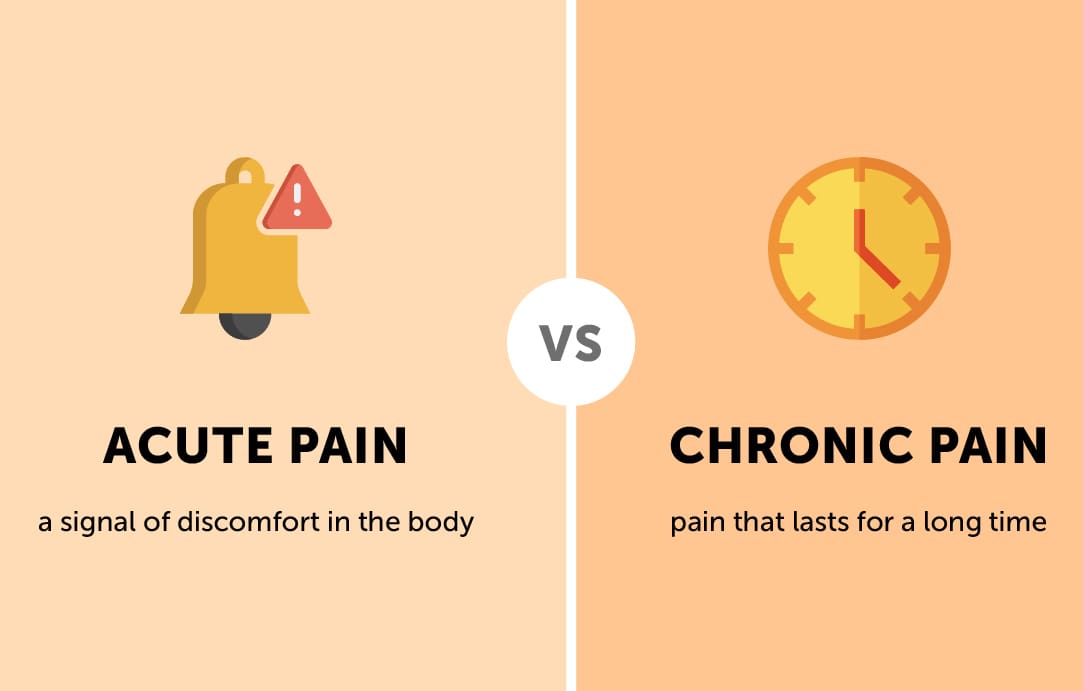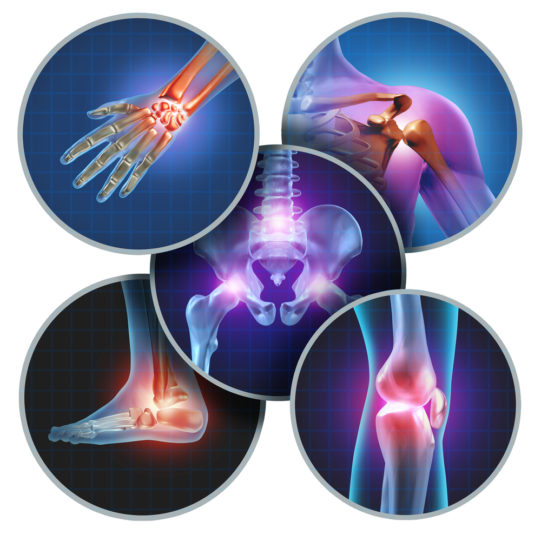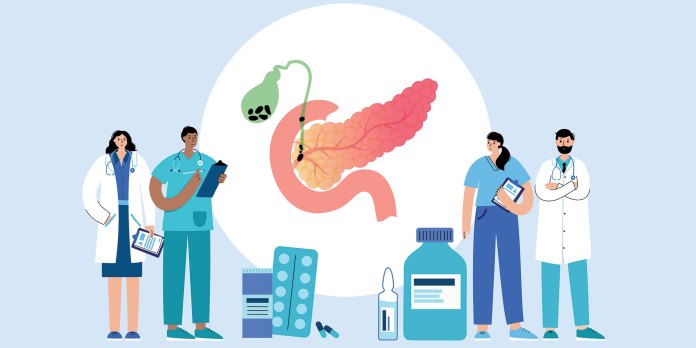ACUTE PAIN VS CHRONIC PAIN
Pain is described as an unpleasant sensation which is caused by actual or perceived injury to body tissues causing physical and emotional reactions. Pain is categorized as acute, that comes on suddenly and is caused by something explicit and chronic, it usually lasts longer than six months and is ongoing.
Regardless of the type of pain, it can range from mild to severe. All pains have the ability to reduce the quality of life and prevent patients from living the life they deserve.
The most important difference between acute and chronic pain, is that acute pain has a specific, treatable cause whereas chronic pain could not be easily diagnosed as it might be rooted in underlying or invisible causes.

ACUTE PAIN
Acute pain is usually described as a sudden, sharp pain lasting less than 6 months. Acute pain is a warning to the body that it is not safe and the health has been compromised. Acute pain ranges from mild to severe and is temporary as well as acute pain is very complex. Acute pain may be caused due to an injury or illness that would last only as long as the condition. Once healed the injury would no longer signal pain. In most cases, acute pain might be uncomfortable; however it isn’t a serious health concern.
Acute pain might vary significantly and could be categorized into two main types: spontaneous insult or trauma and elective or planned procedures.
SPONTANEOUS INSULT OR TRAUMA
The pain is mild that occurs due to spontaneous conditions such as headache, upper respiratory infection, or a sore back. This could be self-treated with RICE (rest-ice-compression-elevation) therapy and over-the-counter (OTC) analgesics.
Conditions such as sprained ankle, strained ligament, deep laceration, or simple bone fracture are moderately painful which may require interventions including minor outpatient surgery or splinting; however they are generally managed with nonsteroidal anti-inflammatory drugs (NSAIDs) like acetaminophen, and RICE therapy.
Conditions like trauma due to accident, traumatic amputation, or burn are severely painful, and involve surgery and a protracted hospital stay along with stronger combination of analgesics, like opioids might be required. The level of pain for each case must be individually determined.
ELECTIVE OR PLANNED PROCEDURES
Some of the office procedures, such as immunizations, phlebotomy, or catheter placement, might result in mild acute pain. This is usually reduced with application of topical lidocaine/prilocaine (EMLA), lidocaine, ice, or devices such as buzzy (combines the application of ice and vibration). Procedures like same-day dental, arthroscopic, laparoscopic, or podiatric surgeries are moderately painful that may be managed with simple analgesics, like NSAIDs and acetaminophen.
However; procedures like surgeries requiring inpatient stays, like orthopedic joint replacement, spine surgery, or colorectal surgery are severely painful. They would require a combination of strong opioids and analgesics, usually starting preoperatively.
Treatment for acute pain includes therapy to reduce the cause of the pain. However, it might be complicated to diagnose acute pain as the symptoms could start and stop without warning. The pain usually does not last all day and night, and could induce symptoms that last a few days, a few weeks, or even just a few seconds.

CHRONIC PAIN
When the pain lasts for more than three months, it is referred to as chronic or persistent pain. This may require help from a health care provider, to diagnose the cause of pain and determine treatment to reduce pain as well as associated symptoms. Chronic pain could be caused due to numerous reasons including physical effects like tense muscles, limited mobility, a lack of energy, and changes in appetite and emotional effects like depression, anxiety, anger, and fear of re-injury. Several different types of pain can trigger chronic pain lasting for days to months.
Chronic pain is of many types such as headaches, arthritis, cancer, nerve pain, back pain, and fibromyalgia. Pain differs from person to person, especially chronic pain due to which the treatment options for chronic pain also vary and can include topical cream, medicines, therapies and surgery.
Oral medications and creams or ointments like over-the-counter (OTC) anti-inflammatories, pain relievers, and topical creams help in reducing pain on a daily basis. However; these are not meant for long-term use.
Physical therapy or treatments without medication are proven to help ease off chronic pain, increase quality of living as well as minimizing medication dosages in patients. Other treatments such as acupuncture and TENS stimulation might also be beneficial. TENS units use external pads providing stimulation around the area of pain and reduce pain.
People suffering from severe chronic pain are appropriate candidates for injections. The injections are a mixture of an anesthetic and steroid which is injected in the affected area of pain to help alleviate the pain. Some common injects include:
- Trigger Point Injections – These help relax and soothe tense muscles which are inflamed and are painful.
- Facet Joint Injections – These help inflamed joints in the spine by using steroids to help reduce pain and joint soreness.
- Epidural Injections – These are strong anti-inflammatory injections which reduce pain around the spinal cord.
DIFFERENCE BETWEEN ACUTE PAIN AND CHRONIC PAIN
You would have experienced pain at some point if you have lived any appreciable amount of time. It might result from merely stubbing your toe or from the almost unbearable agony of accident or cancer. Pain is something that you want to avoid. In simplest words, pain is a biological signal that indicates some harm has occurred to the body, however; pain could be much more complex.
Acute pain is the most common type of pain which is caused from an injury or illness and lasts only till the condition. Once the injury or illness is recovered the pain will also be resolved. In major cases acute pain could not be forgotten but it does not lead to any serious health concern.
On the contrary, chronic pain persists for long duration ranging from three to six months or longer and might not have an obvious cause. In many cases, chronic pain might begin as acute pain related to an injury or disease and may continue long after the underlying health condition is resolved.
Acute pain serves a purpose like warning the body of some damage or illness, however; chronic pain might not always serve a purpose of warning of damage or illness (idiopathic chronic pain).
Acute pain is usually localized to the area of damage but the effects of chronic pain might go beyond the sensation of pain, such as muscle spasm, decreased range of motion, decreased strength, fatigue, and appetite changes. The effects not only impact the patient’s physical health but also alter the mental health.
Treatment of acute pain would focus on treating the underlying medical condition. On the other hand, chronic pain treatment mainly focuses on self-management to reduce the symptoms and increase quality of life.

OUTLOOK
Everyone perceives pain differently, which makes pain a subjective experience. There is no classic test which could measure an individual’s pain level as well as locate the exact area of pain. Therefore, it is important to keep a track of your pain so that it becomes easy to describe the location, type, and timing of the symptoms you are experiencing to your physician. This would make it easier to determine the underlying cause of your pain and prescribe a treatment regime to provide relief from your symptoms.
If you or anyone you know is suffering from acute pain or chronic pain, our expert providers at Specialty Care Clinics will take care of your health and help you recover.
Call us on (469) 545-9983 to book your appointment with Dr. Mohammad Zulqarnain.
